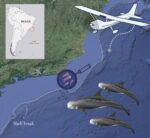Distribution patterns of Risso’s Dolphin, Grampus griseus, in offshore waters of Southeast Brazil assessed by aerial surveys
Caroline Portal, Daniel Danilewicz, Paulo H. Ott, Federico SucunzaThe Risso’s dolphin, Grampus griseus, is widely distributed in temperate and tropical ocean waters around the world. Despite the known occurrence along the Brazilian coast, information regarding the spatial distribution of the species is scarce. Here we evaluated the distribution pattern of Risso’s dolphins using records obtained through 200 h of dedicated aerial surveys for marine mammals off the slope and outer continental shelf of Southeast Brazil, conducted between March and May 2012. A total of 16 groups of Risso’s dolphins was recorded with a median group size of 35 individuals (range = 1–300). Environmental variables (i.e., depth, slope, distance to the coast and to the shelf break, and sea surface temperature) associated with the Risso’s dolphin groups recorded indicate an oceanic distribution pattern, occurring close to the shelf break, what is probably related with foraging activity. This study provides new information about the distribution of Risso’s dolphins in Brazilian waters, and could be used as basis to plan conservation actions.
Padrões de distribuição do golfinho-de-Risso, Grampus griseus, em águas oceânicas do sudeste do Brasil, avaliado através de levantamentos aéreos. O golfinho-de-Risso, Grampus griseus, apresenta ampla distribuição em águas tropicais e temperadas ao redor do mundo. Apesar da ocorrência conhecida ao longo da costa brasileira, informações a respeito da distribuição espacial da espécie são escassas. Neste estudo, avaliamos o padrão de distribuição do golfinho-de-Risso usando registros obtidos através de 200 h de sobrevoos dedicados para observação de mamíferos marinhos no talude e plataforma externa do sudeste do Brasil, conduzidos entre março e maio de 2012. Um total de 16 grupos de golfinhos-de-Risso foi registrado com uma mediana de tamanho de grupo de 35 indivíduos (variação = 1–300). Variáveis ambientais (i.e., profundidade, declividade, distância da costa e para a quebra da plataforma, e temperatura superficial da água) associadas aos grupos de golfinhos-de-Risso registrados indicaram um padrão de distribuição oceânico, ocorrendo próximo da quebra da plataforma continental, o que está provavelmente relacionado com atividade de forrageio. Este estudo fornece novas informações sobre a distribuição dos golfinhos-de-Risso em águas brasileiras, e pode ser usado como base para planejamento de medidas de conservação.
